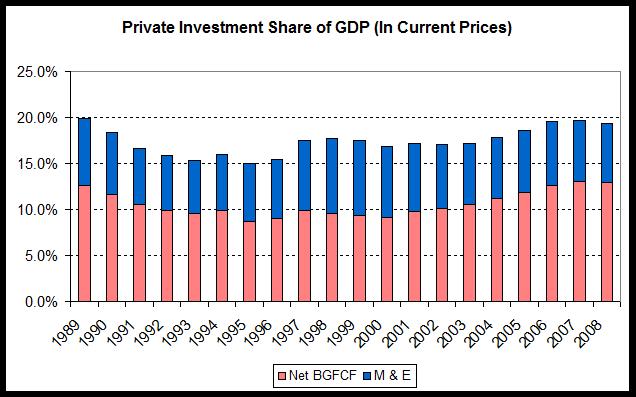In this recession-plagued period, it would be logical for the public to also pay attention to that often-overlooked component of economic activity, gross investment. Government economic agencies expend a great deal of effort estimating the total size of economic activity, how rapidly it is moving along and how well economic growth translates to a better standard of living for all. In the expenditure approach to estimating gross domestic product (GDP), gross investment is every bit as vital as the other four components: private consumption, government expenditures, and export revenues less import outflows. In the current context, both the public and private contributions to gross investments (World Bank, 2010) may be just as crucial. Government investment, normally limited to infrastructure like roads and dams that the private sector has little incentive to invest in, gets partly allocated to “pump-priming” investments like jobs creation when the economy is in the doldrums, as it is today. But trends in private investment deserve even more attention because the private sector can create many more jobs than government ever can, at least in the free-market economies of the industrialized nations. Moreover, private-sector investment in the factors of production– land, factory buildings, oil field development, fishing vessels, machinery and equipment – can be considered the true engine of growth since it must be undertaken before new employment can be generated and create trickle-down effects.
The history of business gross fixed capital formation (BGFCF) and capital-intensive machinery and equipment in the most recent two decades (Statistics Canada, 2009a) reveals, first of all, that when reckoned in current prices, BGFCF and its machinery and equipment component have not been the primary drivers of Canadian GDP. The trend lines alone (Figure 1, overleaf) suggests that other expenditure items must have driven GDP to grow briskly since these two investment elements evinced comparatively sluggish growth.
Table 1:
As the table alongside shows, GDP was reckoned to have grown 143.3% over the 20-year reference period whereas BGFCF expanded somewhat more slowly and private-sector outlays for machinery and equipment lagged most of all.


After netting out M & E so the two can be tracked as an additive stacked bar over the years (see Figure 2) and showing both as a percentage of GDP, one comes to the rather stunning conclusion that both aspects of private-sector investment have perennially contributed 20% or less of GDP, evinced a lower share for the most part and had only began to recover to that starting point during the last three years of the reference period. A closer look at these investment components with price inflation factored out (Statistics Canada 2009b) reveals that BGFCF was on the upside of a decade-long expansion in real activity until stopped in its tracks by the U.S. recession.
References
Statistics Canada. (2009a). Table 380-0017 – Gross domestic product (GDP), expenditure-based, annual. Web.
Statistics Canada. (2009b). Table 380-0017 Gross domestic product (GDP), expenditure-based, annual (dollars unless otherwise noted). Web.
World Bank (2010). Statistical manual: GDP, final output. Web.